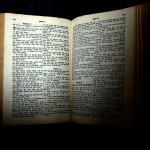Hoping to put a dent in my qualifying exam reading lists, and given the fact that I am a slow reader, I have resorted to focusing on introductions and conclusions, while skimming the rest. And what should I encounter but this incriminating passage:
I have long been annoyed by introductions that are largely devoted to succinct summaries of arguments and ideas presented in the bulk of a book. They usually serve only the purposes of lazy readers who desire to be knowledgeable about books without actually having read them. Therefore the reader will not be provided here with shortcuts to the ideas developed in this book. I would like to see [the] … work being tackled in depth rather than becoming the ephemeral topic of academic cocktail parties.
Guilty as charged. Remorseful? Yes. Will I do it again? Absolutely. In fact, I already have.
Here are my notes (mostly lifted directly without quotation marks but also including some paraphrasing) from the introduction to Recovered Roots: Collective Memory and the Making of Israeli National Tradition, by Yael Zerubavel:
Zerubavel looks at Israeli recollection and reconstruction of fall of Masada (73 CE), Bar Kokhba revolt (132-135CE), and defense of Tel Hai (1920); she explores invisible ties between living and dead made through commemoration; any commemorative narrative involves the deliberate suppression of memory; she relied on a variety of sources, from written to visual to oral, including interviews; commemoration is important for understanding the dynamic character of group memory; collective memory creates a particular periodization and evaluation of the past and turns certain events into political myths; Zerubavel explores how a historic battle in which several settlers die and the survivors evacuate the settlement can become a myth of successful defense and symbol of ‘no retreat’ (Tel Hai); how the leader of a revolt that ended with defeat is remembered as a legendary hero who led the people to freedom (Bar Kokhba); how a historical episode that ends with a collective suicide is transformed into a myth of fighting to the bitter end and a symbol of national renewal (Masada); Zionist commemorative literature was supported by the emergence of new commemorative rituals; the commemoration of historical events is not only a powerful means of reinforcing social solidarity but also an arena of struggle over power and control.
And from the conclusion:
Nationalist movements typically attempt to create a master commemorative narrative the highlights their members’ common past and legitimizes their aspiration for a shared destiny; this is one of the most important mechanisms by which a nation constructs a collective identity for purposes of an ‘imagined community;’ memory shapes the representation of the past and is highly selective; while some aspects of the past are uncovered or shift from the margins to the center of our historical consciousness, other aspects of the past are marginalized or fade into oblivion; any remembrance thus entails its own forgetfulness, as the two are interwoven in the process of producing the commemorative narratives; this accounts for the emergence of multiple representations of the past over time or by different groups; the rhetoric of change and continuity is an important dimension of the construction of a national memory and tradition; reformist and revolutionary movements tend to highlight their departure from the past and play down their continuity with what they regard as a discredited political and moral order; conservative movements, in contrast, prefer to obscure changes and emphasize their continuity with the past; the holiday cycle can be seen as a semiotic system that offers an nonhistorical framework of representation of the past; the holiday cycle determines which aspects of the past become more central to collective memory and which are assigned to oblivion; the holiday cycle thus subverts history through its perpetuation of mythical representations of the past; by adjusting history into these mythical molds, the holiday cycle continues to shape the understanding of the past to a greater extent than we would like to acknowledge; use of myth plot structures (e.g. few against many); collective memory can help construct the nation’s identity during its formative years but it can also turn into a contested arena that highlights social and political divisions.
As I (pretended to) read Zerubavel, I could not help thinking about how her analysis might be applied to our own Zionist movement. Are we perhaps guilty of creating a particular periodization and evaluation (Apostasy, Dark Ages) of the past and turning certain events into politico-religious myths (corruption of scriptures, loss of priesthood and temple ritual)? As a reformist and revolutionary (Restoration) movement, have we possibly tended to highlight our departure from the past (revelation) and play down our continuity with what we regard as a discredited politico-religious and moral order (Apostasy again)? More recently, as a conservative movement, have we maybe preferred to obscure changes (such as polygamy, priesthood ban) and emphasize our continuity with our own past (dispensations)?
In discussing instances of Israeli Jews learning later in the life when they go away to college that, no, Bar Kokhba was not victorious over the Romans but actually lost the war, she mentions how the ability to compartmentalize knowledge is so great that history and memory can coexist without apparent friction in some people, whereas others produce counternarratives: “The emergence of countermemories and the greater visibility that they enjoy in contemporary Israeli culture have become so pronounced during the last two decades that Israeli discourse has labeled this phenomenon niputs mitosim (shattering of myths). While some Israelis regard the process if ‘demythologization’ as a necessary response to the excessive glorification of the national periods by earlier generations, others consider the shattering of myths a subversive act that undermines the sacred foundations of Israeli society.” These and other responses to the apparent gaps between memory and history, or better, between two types of knowledge, might also be identified throughout the Mormon blog microcosm. Are some of us highly skilled at compartmentalization, others engaged in the shattering of myths as a painful but needed process, and still others opposed to such insurrection and sacrilege?
To come back to the beginning, at the same time I was thinking about the potential application of Zerubavel’s book to Mormonism, I could not help thinking about how her analysis might also be applied to academic disciplines, schools of thought, and methodologies. What are departmental reading lists and comprehensive exams if not attempts to create a master commorative narrative or collective memory that highlights students’ common past and legitimizes their aspiration for a shared destiny (getting a job) in an ‘imagined community’ (e.g. religious studies as opposed to some other department)? Is not each new theoretical approach something of a reformist and revolutionary movement tending to highlight its departure from the past and play down its continuity with what it regards as as discredited order, through the deployment of narrative periodization (e.g. Modern vs. Postmodern, critical vs. precritcal) and myth plot structures (e.g. march of progress)?
In the words of Fantastic Mr. Fox, oh cuss.











